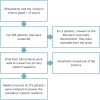Screening with the double surprise question to predict deterioration and death: an explorative study
- PMID: 31881958
- PMCID: PMC6935168
- DOI: 10.1186/s12904-019-0503-9
Screening with the double surprise question to predict deterioration and death: an explorative study
Abstract
Background: Early identification of palliative patients is challenging. The Surprise Question (SQ1; Would I be surprised if this patient were to die within 12 months?) is widely used to identify palliative patients. However, its predictive value is low. Therefore, we added a second question (SQ2) to SQ1: 'Would I be surprised if this patient is still alive after 12 months?' We studied the accuracy of this double surprise question (DSQ) in a general practice.
Methods: We performed a prospective cohort study with retrospective medical record review in a general practice in the eastern part of the Netherlands. Two general practitioners (GPs) answered both questions for all 292 patients aged ≥75 years (mean age 84 years). Primary outcome was 1-year death, secondary outcomes were aspects of palliative care.
Results: SQ1 was answered with 'no' for 161/292 patients. Of these, SQ2 was answered with 'yes' in 22 patients. Within 12 months 26 patients died, of whom 24 had been identified with SQ1 (sensitivity: 92%, specificity: 49%). Ten of them were also identified with SQ2 (sensitivity: 42%, specificity: 91%). The latter group had more contacts with their GP and more palliative care aspects were discussed.
Conclusions: The DSQ appears a feasible and easy applicable screening tool in general practice. It is highly effective in predicting patients in high need for palliative care and using it helps to discriminate between patients with different life expectancies and palliative care needs. Further research is necessary to confirm the findings of this study.
Keywords: Death; General practice; Identification; Palliative care; Prediction.
Conflict of interest statement
The authors declare that they have no competing interests.
YE is a member of the editorial board (Associate Editor) of this journal, but the editorial board had no role in the editorial process of this manuscript. No support from any organisation for the submitted work.
No financial relationships with any organisations that might have an interest in the submitted work.
No other relationships or activities that could appear to have influenced the submitted work.
Figures
References
-
- Higginson IJ, Bausewein C, Reilly CC, Gao W, Gysels M, Dzingina M, et al. An integrated palliative and respiratory care service for patients with advanced disease and refractory breathlessness: a randomised controlled trial. Lancet Respir Med. 2014;2(12):979–987. doi: 10.1016/S2213-2600(14)70226-7. - DOI - PubMed
MeSH terms
LinkOut - more resources
Full Text Sources
Medical


